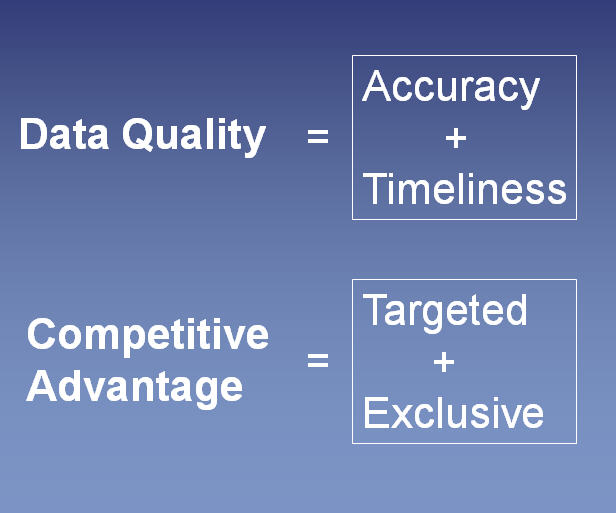Proving ROI is what will empower one of my clients at Broadlook to sign up for year #2, 3, etc. Without good metrics, corporate budgets won’t open up year after year. To help my clients track ROI, I’ve put together some concepts over the years to help examine the pipeline of sourced data.
Without a perfect record of all hires, measured against years past, ROI is hard to prove in a single year. Don’t get me wrong, some companies do this very well; however, they are the exception. In most cases, metric must be applied to the pipeline of data and the quality therein. (For recruiters, data=candidates, for sales reps, data=leads)
How do you measure a list? How important is it to keep a particular list updated? What is the frequency that a list should be updated? When is a list too old? What resources should you apply towards building a list? When is it cheaper to outsource the creation of a list vs. build it yourself? Do you want to create a one-time list OR do you need to have a documented, systemic process for keeping a list updated?
What I want to present here today is a concept I call List Metrics. Instead of boring you with numbers and formulas, I am going to share, at a 10,000 ft view of how I think about lists and data.
To determine the value of a list and the resources that should be applied to creating a list, I teach my clients to create a scoring system. One score for an existing list, another score for the importance of creating a list.
Yes, a list can have a score. A list score is determined by 2 factors: Data Quality and Competitive Advantage. Data quality is a combination of Accuracy + Timeliness. Competitive Advantage is weighted by the degree of targeting and Exclusivity.
Some thoughts on the 4 measures of a list:
Accuracy: Does your list give you dead people?
- Is the list static or does it exist within a data-driven website? (1995-2002 static, 2003-2008 data driven)
- Is it someone’s passion? (i.e., top 100 rutabaga growers (Typically high quality, timely, comprehensive))
- Was any verification process used?
- Is the list mandated via state or federal? (Registered Professionals, Banks & Credit Unions, Hospitals, SEC filings)
Timeliness: How often is the list updated?
- By the minute (Federal contract opportunities) www.gsa.gov, www.ebay.com
- Hourly (Job Boards, Social Networking Sites) www.monster.com, www.linkedIN.com
- Daily (Find an agent pages, Associations) www.prudential.com, www.mbag.org
- Weekly (Chambers of Commerce, Trade Shows)
www.pheonixchamber.org, www.summitcustomerconference.com - Quarterly (some CD databases, Hoovers, D&B)
- Yearly (Top 100 lists, InfoUSA, Printed lists)
Targeted: (the right 50 or the wrong 500)
- Is it categorized by a outdated concepts such as SIC codes or general industry classifications?
- Does it serve a niche market? (List of Microsoft CRM resellers)
Exclusive: Who else has YOUR list?
- Was the list made for profit? Is it for sale?
A custom created list is always far superior then renting a list from a source that will sell it to anyone who coughs up the $$ - Does your #1 competitor have access to the same data as you?
Every single online database falls into this category, Zoominfo, Spoke, etc. It does not matter how large a database is if everyone has access to the same tiny fish bowl. - How many times was your list sold?
- Are the same people from the same companies being called over and over?
Developing a scoring system:
Every niche in recruitment or lead generation will have varing degrees of importance. In one business, fresh data may be more important, in another…lets say in a comodotized market, it may be exclusivity. Determine which of the 4 factors are most important to you. Next, using a 5 point scale, plot the “score” of your list by placing it on a Gartner magic quadrant.
For recruiters, the most valuable list would be one that (1) exclusive and (2) fresh data. Typically, this type of list is created on demand based on a current need.
YOU CAN’T BUY A LIST LIKE THIS.
You can commission one to be created from a great name sourcer like Maureen Sharib. This type of custom list has high value. I am surprised more recruiters don’t use name sourcers and research for hire.
FISH BOWL DATABASES
As more “online” databases proliferate, more and more people will be fishing in the same fish bowl of overused candiates and sales prospects. Why fish from a fish bowl when you can go directly to the ocean? If everyone has access to the same fish bowl, it doesn’t matter how big it is. We all know what happens when a fish bowl gets too populated…

THE GROWING TREND OF NAME SOURCING
The demand will continue to grow in the next few years for researchers and name sourcers. Recruiting and sourcing are diverging into separate entities. I am excited that Broadlook is announcing our Broadlook Remote Research program early next week. We’ve had it running in stealth for about four months now. Combine a fully trained researcher in concert with an entire suite of Broadlook tools. Put them to work for either 16, 20 or 40 hours per week. Instant staff augmentation. We’ve had overwhelming success. Fun stuff.
Thank you to all the clients that piloted the program with us and help us work out the kinks.
